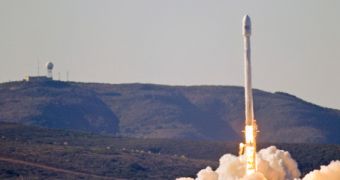Officials with Hawthorne, California-based Space Exploration Technologies Corporation (SpaceX) are anxiously awaiting the launch of their latest resupply mission to the International Space Station (ISS). This flight will enable the company to test for the first time ever the possibility to steering rocket boosters back into the atmosphere following launch.
If successful, SpaceX will achieve a spaceflight first, and the second major achievement for a private space company. A short while back, the corporation became the first private organization to launch a cargo spacecraft into space, aboard its own rocket, the medium-lift Falcon 9.
On March 30, the company is scheduled to launch its third CRS flight to the ISS, meant to deliver a wide array of supplies, experiments and cubesats to the orbital outpost. The mission will be conducted using an improved version of the Dragon cargo capsule, which will sit atop a new version of the Falcon 9 rocket, called F9R.
What sets this rocket booster apart from its previous versions, as well as from all other rockets, is the fact that it will be able to fire the engine on its first stage twice. The rocket will take off as usual, and then deliver Dragon into low-Earth orbit. Afterwards, instead of simply falling to the ground and disintegrating into the atmosphere, the rocket stage will fire off its engine yet again.
What SpaceX experts want to achieve is a controlled atmospheric reentry, which would ensure that the booster is not destroyed. The rocket section is expected to fall in the Pacific Ocean, somewhere close to the Cape Canaveral Air Force Station. This is also where the mission will take off from, either on March 30, or an April 2, Technology Review reports.
In order to cushion its landing, the rocket will extend four landing legs as it approaches the surface of the Atlantic, and will then fire off four smaller motors. These will enable it to hover a few meters above the ocean. Eventually, its motors will be cut off, and the booster will fall for the last few yards into the water. Recovery crews will then tow it back to the CCAFS.
This version of the Falcon 9, called F9R, will in the future land on the ground, probably at the CCAFS, or at the nearby NASA Kennedy Space Center. Since this is the first time that such a landing will be attempted, SpaceX officials did not want to take any chances with destroying the prototype.
Developing and refining the F9R will enable SpaceX to compete with the United Launch Alliance, a collaborative effort between Boeing and Lockheed Martin, for Evolved Expendable Launch Vehicle (EELV) contracts to launch US Air Force satellites in space.

 14 DAY TRIAL //
14 DAY TRIAL //